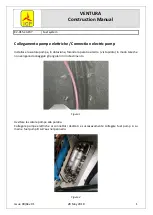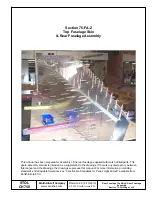
10
11
leading edge might look spectacular however it is not really dangerous, as far as the collapsed part is not too
big. Normally no rotations occur during a frontal collapse and the paraglider quickly reopens unassisted, to
return to normal flight again.
Braking evenly on both sides will speed up the opening of the leading edge.
Early recognizing of the situation and a fast reaction by evenly dosed breaking of both sides helps you to
keep the loss of height very small and avoids an escalation of this flying incident.
12.4. Parachutal stalls:
During a parachutal stall a paraglider has no forward movement anymore but very big sinkrates. Letting go of
the B-risers too slowly exiting a B-stall with old porous material , damaged lines or ribs, pulling the C or D-riser
or incorrect take off weight can result in the glider going parachutal falling vertically but still holding its shape.
The tendency for a parachutal stall is also increasing if the canopy is wet or the air-temperature is very low.
You can tell whether or not your paraglider is parachutal, as the flying noise can hardly be heard even though the
brakes are free and you are sitting in your unusual position under the canopy. Normally, letting up on the
steering lines will allow the glider to resume normal flight.
If the canopy and the lines are in good working condition, the Garuda will speed up again automatically after 2-3
seconds. Should this fail to happen you must push the A-risers forward or use the speed-system of the glider.
Does the glider stay in a repetitively parachutal stall without any noticeable reason (e.g. wet canopy, wrong
take-off weight), the glider have to be checked before the next flight by your dealer or by the manufacturer.
Attention: Never pull the brake-lines during a parachutal stall, because the glider would go into a full stall
immediately. Near the ground a parachutal stall should not be released because of possible pendulum
movements. Instead the pilot prepares for a hard touch down.
12.5. Fullstall:
You can only induce a full stall if the both brake lines are completely pulled through and remaining in this position
for more than one second. When stall speed is reached the canopy will empty itself at once, the pilot is hurled
forward and the impression is given that the canopy falls backwards.
It is vital to keep the brakes pulled down until the empty canopy is above the pilot again (this will take 3-6
seconds). If you let go of the steering lines with the paraglider still behind you, the glider will shoot forward
and dive in front. Not until the glider is above the pilot again the steering lines can be released moderately
quick and symmetrically. The perfect ending to a full stall should take place in two steps:
1) slow refilling of canopy (slow loosening of brakes, approx. up to the shoulder) until the canopy is
reopened completely, then
2) releasing the brakes altogether
If this manoeuvre is released too fast or asymmetrically the glider can collaps frontal or asymmerically.
Attention: A wrong, too early, asymmetrically or too fast released fullstall can cause an extreme forward
movement of the canopy. In an extreme case the canopy will shoot and dive under the pilot.
12.6. Negative Spins:
Pulling down hard on one brake can cause the air stream to break away on that half of the wing. A reversion of
the air-stream direction can occur. The slowed half flies in the opposite direction. The paraglider then turns
around its vertical axis. For negative spins there can be two reasons:
- one brake-line is pulled too fast and too far. (e.g. while entering a deep spiral)
- during slow flying one side is braked too much (e.g. while flying circles in thermals)
If an unintentional negative spin is released immediately during it´s beginning, the glider normally goes back into
normal flight without loosing lots of height. But if the negative spin is kept for a longer time and the glider can
accelerate in this negative spin the release of the spin can cause the canopy to move extremly asymmetrically in
front of the pilot. Big collapses and cravats can be the result!!
gliders for real pilots
independence
www.independence-world.com
gliders for real pilots
independence
www.independence-world.com
12.7. Wingover:
Narrow turns to the left and to the right are flown alternately. During that moves the bank is increasing more and
more. If there is too much dynamic and bank the wing´s outer side can loose pressure. If the bank is increased
further and the pilot reacts wrong (timing!) a big part of the glider can collapse impulsively!.
Fullstall, Negative Spins and Wingover (over 90 dergrees) are prohibited
aerobatic (acro-) moves!!! Doing these manoeuvres wrong or a wrong reaction of
the pilot can generally be very dangerous and life-endangering with all
paragliders!!!
12.8. Emergency-steering:
In the event of loosing control of the steering lines, the Garuda can be flown easily with the rear risers (D lines). A
stall happens quicker when steering with the rear risers, as if steered with the brake lines. The way of steering
with the rear risers ia at approx. 15-20cm with the Garuda. Light turns can be flown using the stabilo lines or by
shifting your weight.
13. Descending manoeuvres:
13.1. Spiralling:
Spiralling is the most efficient way to descend quickly. However, this causes a lot of strain for the paraglider as
well as the pilot. Please be aware that, according to your fitness, outside temperature (cold) and descent rate,
you could loose consciousness. Many pilots lower their breathing rate or start hyper ventilating, both of which
heighten the risk of loosing control.
With the first signs of sickness, weariness or blurred eye sight you must stop spiralling immediately.
To enter a spiral you carefully but constantly pull at the brake-line on one side and move your weight-shift to the
curve´s inner side. By it´s direct handling the Garuda fast increases bank and flies a steep curve. As soon as the
glider gets in front of the pilot ( glider is “getting on it´s nose” ) there is an impuls which the pilot should follow
and move his weight to the curve´s outer side.
Sink-speed and bank during the spiral can be variied by dosed pull on the curve inner-side´s brake-line.
A light braking of the curve´s outer side gives the wing more stability and avoids a folding of the outer wing-tip.
To exit a spiral the brake-line on the curve´s inner side is released slowly.
A too fast release will have the consequence that the high flying-speed (up to more than 100km/h) will be
transformed into height by a massive pendular movement. An extreme deceleration at the end of this pendular
move will occur, which causes the canopy too move far backwards. Also you have to be prepared that you fly in
your own wake turbulence.
Because such spirals are wasting lots of height you always have to take care that you have still enough safety-
height!
Attention: Nearly every paraglider at some point reaches a sink-speed at which the canopy moves with it´s
frontal edge downwards (glider is “getting on it´s nose”) and stays in this position and keep spiralling (stabile
steep-spiral), even if the brake-line is released.
This can happen, caused by disadvantageous influences, even earlier than at the sinkrate of 14m/sec which is
tested during the certification flights. The reasons therefore can be complex, some examples: Geometry of the
harness, cross-belts at the harness, moving of the pilot´s weight to the inner side of the curve, and some more.
Should against all expectations a stabile steep-spiral occur, you can stop it by moving the pilot´s weight to the
curve´s outer side and dosed braking of the outer side.
Attention: during a stabile steep-spiral very high G-forces will occur, which require a high strain of a
physical fit pilot!
.

























